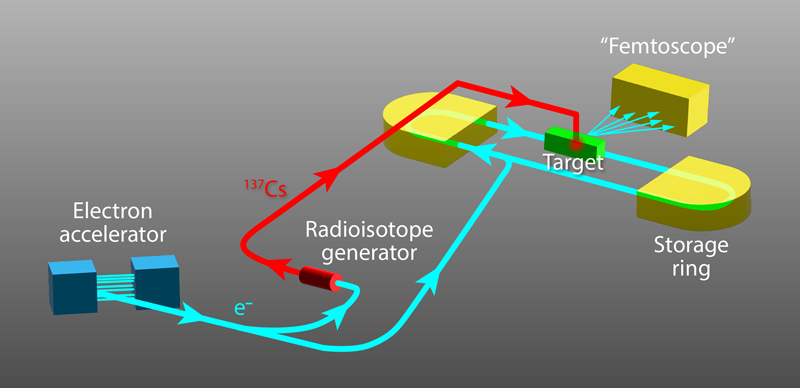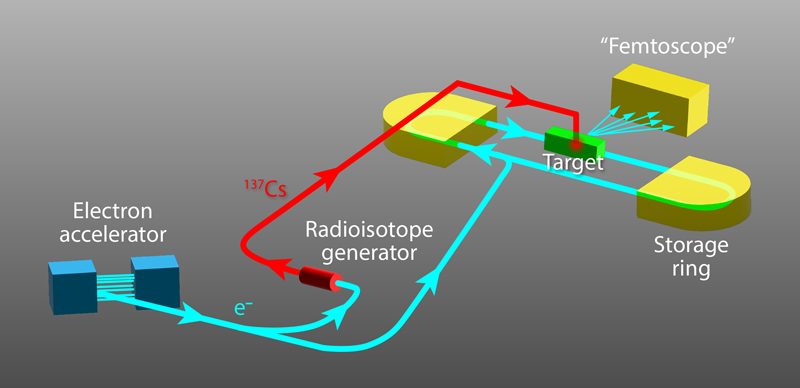What Do Unstable Atomic Nuclei Look Like?
Since the pioneering measurements of Robert Hofstadter and co-workers in the 1950s, it has been known that atomic nuclei are not point-like particles but have a finite size on the femtometer scale—about 10,000 times smaller than the atomic radius [1]. That Nobel Prize winning research revealed the internal structures and distinct spatial electric charge distributions of nuclei by directing high-energy beams of electrons from an accelerator toward the target materials and examining the directions in which the electrons were deflected. At the RIKEN Nishina Center for Accelerator-Based Science in Japan researchers have, for the first time, observed such electron scattering from radioisotopes that do not occur naturally [2]. The physicists achieved this long-awaited result through successive advances in accelerator technology and novel methods in producing and trapping ions. Their success marks the realization of the anticipated “femtoscope”—a femtometer-scale microscope—which could picture atomic nuclei in up-to-now inaccessible areas of the nuclear chart.
The team’s approach exploits a version of a phenomenon used commonly in optical analysis techniques. When laser light shines through a pinhole, it produces a diffraction pattern: a bright disc at the beam axis surrounded by a series of concentric rings with diminishing intensity. The size and shape of the pinhole determine the details of the angular distribution. Quantum mechanics teaches us that, on the scale of atomic nuclei, an electron beam can be regarded as a wave. Analogously to light optics, therefore, we can infer the spatial structure of the objects under investigation from the diffraction pattern of the electrons reflected by the sample. High-energy electron scattering is described by a simple and well-understood interaction: the electromagnetic force acting on charged objects. Accordingly, with incident electron energies of the order of a few hundred mega-electron-volts, the internal charge distributions of atomic nuclei are spatially resolved on the order of a few femtometers.
This technique has been applied in many studies of stable nuclei as well as a few very long-lived radioisotopes; in other words, nuclei that are all from the “valley of stability” in the chart of nuclides. Physicists have been unable to explore beyond this valley of stability—where one may expect the appearance of charge distributions with very specific features—because obtaining a diffraction pattern requires confining a sufficiently large number of short-lived nuclei in the target volume.
The RIKEN Nishina Center for Accelerator-Based Science operates the RI Beam Factory, a next-generation heavy-ion accelerator facility where radioisotopes that do not exist in nature are artificially created (Fig. 1). By striking a block of uranium carbide with energetic electrons from a separate accelerator, the RIKEN team produced a beam of radioactive cesium-137 ions with almost 100% purity. The electrons that produce the diffraction pattern circulate in a nearby storage ring. Although the newly created ions can be readily conveyed to this ring, they also need to be concentrated to achieve a sufficiently large collision luminosity—the measure of how likely an electron beam is to scatter from a target.
Researchers have been working for years on trapping ions inside such circulating electron beams [3]. One major advance in this technique came from utilizing the electric force from the circulating electrons to pull the ions to the central axis. An electrostatic potential applied simultaneously to the ions prevents them from leaving along this axis, acting as the electromagnetic analog to a pair of optical mirrors. In this way, the confined ions form a target at rest [4]. Recently, the RIKEN team demonstrated the world’s first use of such a setup to study a stable nuclear target, achieving a high enough luminosity even with the relatively small number of 10 million ions [5]. The team’s latest experiment provides the first such result from an online-produced radioactive nuclear target, with the cesium-137 ions produced only moments before they are trapped in the electron storage ring.
The researchers detected the scattered electrons using a magnetic spectrometer. Like an optical instrument but on a much larger scale, the spectrometer provides the electrons’ angular distribution; in other words, the diffraction pattern. A great advantage of using electrons as an electromagnetic probe is that the electron–nucleon interaction is precisely described by the theory of quantum electrodynamics [6]. This means that the nuclear structure information can be extracted directly from diffraction data without the need to correct for the strong force that binds the nuclei together. The analysis is further simplified because, at the energy scales probed in the experiment, contributions to the scattering pattern from inelastic scattering and from the nuclei’s magnetic properties are also small and can be disregarded.
The results of the analysis come as no surprise: the team’s observations are consistent with the atomic nucleus of cesium-137 having a charge density that is nearly constant in its central region and that falls off over a relatively large range. Such an interior is well-known from many stable nuclei [7]. However, in the future, the technique can be used to probe nuclei far from stability, which are predicted to have more peculiar structures, such as stretched or flattened spheroidal configurations or even axially nonsymmetric nucleon distributions. Those studies will improve our understanding not only of nuclear structures, but also of nucleosynthesis, the astrophysical theory describing the creation of the many different elements in the Universe. In particular, the heavier elements we have on Earth were mostly formed in the interiors of stars and during supernovae. In these complex processes, unstable nuclei play an important role.
Today the complex shapes and different forms of atomic nuclei cannot be described within a fundamental theory. The new electron-scattering studies performed with unstable target nuclei are an indispensable tool in developing a better understanding, and they are only beginning now.
References
- R. Hofstadter, “Electron scattering and nuclear structure,” Rev. Mod. Phys. 28, 214 (1956).
- K. Tsukada et al., “First observation of electron scattering from online-produced radioactive target,” Phys. Rev. Lett. 131, 092502 (2023).
- T. Suda and H. Simon, “Prospects for electron scattering on unstable, exotic nuclei,” Prog. Part. Nucl. Phys. 96, 1 (2017).
- M. Wakasugi et al., “Novel internal target for electron scattering off unstable nuclei,” Phys. Rev. Lett. 100, 164801 (2008).
- K. Tsukada et al., “First Elastic Electron Scattering from 132Xe at the SCRIT Facility,” Phys. Rev. Lett. 118, 262501 (2017).
- T. W. Donnelly and J. D. Walecka, “Electron scattering and nuclear structure,” Annu. Rev. Nucl. Sci. 25, 329 (1975).
- B. Hahn et al., “High-energy electron scattering and the charge distributions of selected nuclei,” Phys. Rev. 101, 1131 (1956).





